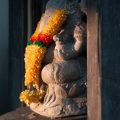1. Introduction: Understanding the Basics
Namaste and welcome to a cosmic journey through the fascinating world of Vedic astrology! If you’ve ever wondered why some days feel so lucky while others seem full of challenges, you are not alone—this mystery is as old as time and deeply rooted in Indian tradition. In our daily lives, astrology is not just about predictions; it’s like chai and samosa—always present at life’s important moments, from marriages to new ventures. Two essential concepts that guide this journey are Dasha and Gochar. Both play a significant role in shaping our experiences, but they do so in their own unique ways. Dasha refers to the planetary periods that influence our personal destiny according to the Nakshatra (constellation) where your Moon was placed at birth, while Gochar deals with the real-time transit movements of planets across the sky. To truly understand how these forces work, we look at two special charts—the Moon chart (Chandra Kundli) and the Lagna Kundli (Ascendant chart). These charts act as cosmic maps, helping us decode planetary energies affecting our relationships, career, health, and spiritual growth. As we embark on this exploration together, keep your mind open and your heart curious. This is more than just astrology—it’s an authentic Indian astrological experience, blending ancient wisdom with everyday life, where each planet’s story becomes a part of your own. Ready for the ride? Let’s dive deeper into the rhythms of Dasha and Gochar!
Dasha: The Power of Timelines in Vedic Astrology
In the colourful world of Vedic astrology, Dasha is like your personal cosmic clock—timing when certain energies and events will unfold in your life. Unlike Gochar (planetary transits), which show what’s happening on a collective level, the Dasha system zooms in on you and the unique journey mapped out in your birth chart. In India, Dashas are often consulted for everything from marriage muhurats to business ventures, making them an essential part of desi daily life and decision-making.
Understanding the Dasha System
Dasha literally means ‘period’ or ‘phase’. There are several Dasha systems in Vedic astrology, but the Vimshottari Dasha is the most widely used. It divides your life into major planetary periods (Mahadashas) and sub-periods (Antardashas), each ruled by one of the nine planets (Navagrahas). Each planet brings its own flavour—think of Shani (Saturn) bringing discipline and challenges, while Guru (Jupiter) blesses with expansion and wisdom.
Moon Chart (Chandra Kundli) as a Foundation
While many people know their Lagna Kundli (Ascendant chart), Dashas are primarily calculated based on your Moon sign placement at birth—the Chandra Kundli. Why? Because the Moon represents your mind, emotions, and day-to-day experience in Indian tradition. This gives Dashas a deeply personal touch; they aren’t just about external events but also your inner growth and feelings during each period.
Dasha Interpretation: Desh-Kaal-Patra Matters
Desh-Kaal-Patra is a classic Sanskrit phrase meaning ‘place, time, and person’. Even if two people have similar Dashas running, their experiences can be totally different based on their family background, regional culture (like North vs South India), and current circumstances. Traditional astrologers always consider these factors along with planetary placements when giving predictions.
Dashas at a Glance
| Dasha Lord | Duration (Years) | General Effects |
|---|---|---|
| Sun (Surya) | 6 | Authority, recognition, leadership |
| Moon (Chandra) | 10 | Mental peace, relationships, emotions |
| Mars (Mangal) | 7 | Energy, courage, conflicts |
| Rahu | 18 | Karmic twists, ambition, confusion |
| Jupiter (Guru) | 16 | Growth, wisdom, luck |
| Saturn (Shani) | 19 | Discipline, delays, maturity |
| Mercury (Budh) | 17 | Intellect, communication, trade |
| Ketu | 7 | Mysticism, detachment, spiritual growth |
| Venus (Shukra) | 20 | Lifestyle comforts, love, art |
This structured timeline lets you understand which area of life will take centre stage at any given time. That’s why Indian families often ask “Which Dasha are you in?” before making big decisions!
![]()
3. Gochar: Transits and Their Everyday Influence
When it comes to Vedic Astrology, Gochar or planetary transits play a major role in shaping daily experiences and long-term events. Unlike Dasha, which is about periods of influence based on planetary positions at your birth, Gochar is all about the current movement of planets in the sky and how these movements impact your life right now. If you are someone who checks Panchang before starting something important or asks for the best Muhurat for a wedding or puja, you are already using Gochar principles in real life!
Gochar Calculations: The Moon Chart and Lagna Kundli Connection
For accurate Gochar predictions, astrologers look at both the Moon chart (Chandra Rashi) and the Lagna Kundli (Ascendant chart). The Moon chart shows how transiting planets affect your mind, emotions, and internal state, while the Lagna Kundli highlights external events—career changes, relationships, health matters, and more. In Indian homes, its common to hear elders say “Check where Saturn is in transit” before making big decisions. That’s because Shani’s (Saturn’s) position can bring delays or challenges depending on its connection with your personal charts.
Muhurat Decisions Made Easy with Gochar
The importance of Gochar can’t be overstated when picking Muhurat—the perfect timing for auspicious events like marriages (vivah), housewarming (griha pravesh), or even starting a new business. Astrologers will check planetary transits through both your Moon sign and Ascendant to ensure harmony between cosmic energies and your birth potential. For instance, if Jupiter is transiting favourably over your natal Moon or Lagna lord, it’s considered an excellent time to begin something significant—think of it as getting the “green signal” from the universe!
Everyday Influence: From Small Rituals to Big Life Changes
Gochar isn’t just for grand events—it influences everyday decisions too. From choosing a good day for travel (yatra) to finding the right moment to buy gold on Akshaya Tritiya, understanding planetary transits helps in making choices that align with universal rhythms. In modern Indian cities and rural towns alike, many still consult their local panditji or use astrology apps to track daily Gochar updates—ensuring that every action is blessed with cosmic support.
In summary, Gochar bridges the gap between celestial movements and our practical lives. By combining insights from both Moon chart and Lagna Kundli during transit analysis, Vedic astrology offers a holistic view—helping you ride life’s ups and downs with confidence and a touch of divine timing.
4. Moon Chart vs Lagna Kundli: What’s the Difference?
When it comes to understanding your destiny through Vedic Astrology, two charts play a big role: the Moon chart (Chandra Rashi) and the Lagna Kundli (Ascendant chart). Both hold their own unique perspectives, but how exactly do they shape your life? Let’s decode this with a desi touch!
Understanding Chandra Rashi and Lagna Kundli
The Moon chart is based on the position of the Moon at your birth. It reflects your inner world—emotions, mind, instincts, and how you react to situations emotionally. On the other hand, the Lagna Kundli is calculated from your rising sign or Ascendant. It shows your outer journey—your physical body, personality, and how you interact with the world.
Real-Life Scenarios: Indian Context
| Moon Chart (Chandra Rashi) | Lagna Kundli (Ascendant Chart) | |
|---|---|---|
| Career Choices | Shows what kind of work environment brings mental peace. For example, a Cancer Moon may prefer caring professions like teaching or nursing. | Indicates visible talents and aptitudes. A Leo Lagna might shine in leadership roles or public-facing jobs. |
| Marriage & Relationships | Emotional compatibility—how you connect with your spouse on a deeper level. Very important in Indian arranged marriages! | Physical attraction, overall partnership dynamics, and family acceptance are seen here. |
| Family Life | Your emotional response to family matters—will you be the peacemaker or the worrier? | Your actual role and responsibilities in family settings. Eldest son/daughter duties? You’ll see it here! |
A Simple Example:
If Ravi has a Taurus Moon but Scorpio Lagna, he might crave stability and comfort emotionally (Taurus Moon), while his outer self is intense and ambitious (Scorpio Lagna). So, he could choose a stable banking career for peace of mind but approach it with fierce determination and drive.
The Bottom Line:
The Moon chart reveals your feelings, while the Lagna Kundli displays what happens on the outside. Together, they provide a complete picture—just like chai and samosa! In Vedic astrology, both are essential for accurate predictions about career growth, shaadi prospects, or family harmony. When analysing Dasha (planetary periods) or Gochar (transits), always consider both these charts for a truly holistic view of your journey.
5. Cultural Context: Indian Traditions and Common Practices
In the heart of Indian culture, astrology is more than just planetary positions—its a living tradition interwoven with everyday life. When it comes to Dasha and Gochar predictions from both the Moon Chart (Chandra Kundli) and Lagna Kundli, the local customs are vibrant and deeply respected.
Consulting Family Pandits
Most Indian families have a trusted family pandit or astrologer who is like a spiritual guide. Before any major decision—be it marriage, business, or even buying a new vehicle—people consult their pandit for advice based on their current Dasha and Gochar transitions. This practice ensures that actions are taken during auspicious times, as shown by both Moon Chart and Lagna-based predictions.
Attending Yagnas and Rituals
Yagnas (fire rituals) are another beloved tradition. When challenging Dashas or tough planetary Gochars approach, families often participate in these sacred ceremonies. The intent is to balance energies, seek divine blessings, and smoothen out any astrological rough patches predicted by their kundlis. These rituals are usually held at temples or sometimes even at home, adding a strong sense of community and spiritual protection.
Simple Remedies (Upayas)
Not every remedy needs grand rituals—many Indians follow simple upayas suggested by astrologers. These can include wearing specific gemstones, chanting mantras, fasting on particular days, or donating food and clothes. Such practices are tailored depending on whether the advice is rooted in the Moon Charts emotional influence or the Lagna Kundlis focus on personal karma and external events.
The Indian Ethos in Action
Underlying all these customs is the uniquely Indian blend of faith, family bonds, and practical spirituality. Whether one leans towards Dasha analysis from the Chandra Kundli or prefers event-based insights from the Lagna Kundli, these traditions help people navigate lifes ups and downs with hope, resilience, and a sense of cosmic connection.
6. Practical Tips: Using Dasha and Gochar in Daily Indian Life
For many of us in India, astrology is more than just a curiosity—its an everyday guide! Whether you’re checking if it’s a good time for your child’s board exams, finalising a wedding Muhurat, or wondering if you should invest in property, understanding the practical use of Dasha and Gochar can make life smoother. Here are some user-friendly tips to help you interpret and apply these powerful tools in real-life situations.
Exam Results: Timing Student Success
If your child is preparing for board exams like CBSE or ICSE, check their Mahadasha and Antardasha periods from their Moon chart (Chandra Kundli). Are they running a Mercury or Jupiter Dasha? Good! These planets are known to support learning and intelligence. For Gochar, see if Mercury or Jupiter is transiting favorable houses from the natal Moon. If Saturn is passing through the 8th house, remind your child to work extra hard and avoid distractions. Parents often consult astrologers during exam season—now you can check these basics yourself!
Wedding Muhurats: Picking Auspicious Dates
In India, no wedding happens without consulting the family pandit! To pick a wedding Muhurat, both Dasha and Gochar matter. Make sure both bride and groom are not under any challenging Dashas (like Shani/Saturn or Rahu) as per their Lagna Kundli. In Gochar, ensure that Venus (the planet of marriage) is well-placed—ideally transiting the 1st, 7th, or 11th house from the Moon sign. Avoid periods when Mars or Saturn is causing Dosha (like Mangal Dosha) in either chart. This double-check makes sure shaadi preparations go smoothly!
Property Buying: When to Invest?
Planning to buy a new flat in Mumbai or invest in land near Bengaluru? Check your Dasha first: periods ruled by Mars (for land), Venus (for luxury homes), or Jupiter (for expansion) are generally positive. In Gochar, see if Jupiter or Venus is moving through your 4th house (property/real estate) from the Moon chart—a classic sign of Griha Pravesh time! If Saturn is transiting your 4th house, delay big decisions or double-check all documents before signing.
Quick Desi Tips for Everyday Use
– Combine Dasha & Gochar: Always look at both! A good Dasha with a bad Gochar might bring mixed results.
– Trust Your Gut: Astrology guides you, but your intuition matters too.
– Ask Elders: Sometimes dadi-nani’s advice matches astrological wisdom—they know which Dashas worked for the family!
– Simplify Charts: Focus on key planets (Jupiter, Venus, Saturn) for most daily events.
– Avoid Overthinking: Don’t let one tough transit stop you from living life; use astrology as a supporting tool.
The next time you have a major decision coming up—be it exams, shaadi, or investment—try applying these easy Dasha and Gochar checks. With practice, you’ll become your own family astrologer!
7. Conclusion: Harmonising Destiny and Free Will
In the vibrant tapestry of Indian life, where tradition meets modernity at every turn, understanding both Dasha and Gochar through your Moon chart (Chandra Kundli) and Lagna Kundli isn’t just about predicting the future—it’s about living with intention. When we compare Dasha (the unfolding of karmic cycles) and Gochar (transits that bring daily cosmic flavours), we see how each uniquely shapes our path, like the monsoon rains nurturing a field sown with seeds.
By tuning into the insights of both your Lagna and Moon charts, you’re equipped to honour your roots while navigating today’s fast-paced world. Whether you’re deciding on a new job in Bengaluru, planning a family puja, or simply wondering why certain days feel heavy or light, these Vedic tools help you move with awareness—not superstition. The beauty of Indian astrology is its deep respect for both destiny (prarabdha) and free will (purushartha), teaching us that while the stars may show the way, it’s our choices that shape the journey.
Embracing this dual wisdom, you can make decisions that resonate with your personal dharma and cultural values. Whether you consult your panditji before a big step or quietly reflect on your planetary periods during chai time, Dasha and Gochar empower you to harmonise fate and free will—making every moment a conscious celebration of your unique Indian story.


